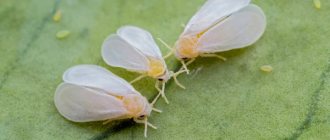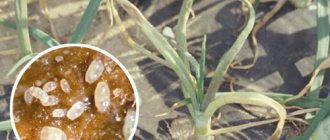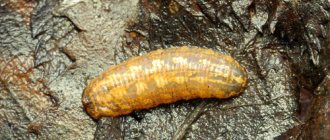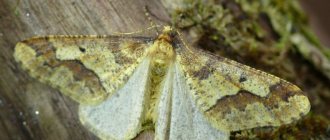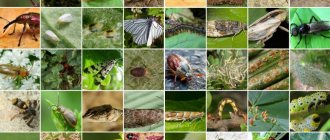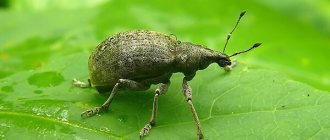It is almost impossible to develop a root crop variety that is resistant to all pests and diseases. Carrots are also not immune to various misfortunes.
To get the maximum possible harvest of this tasty and healthy vegetable and preserve it until spring, you need to know about the most common pests and measures to combat them.
Most often, carrots cause harm:
- carrot fly,
- carrot psyllid,
- naked slugs, carrot aphids,
- carrot moth,
- fall armyworm,
- wireworm
carrot fly
The most common pest of carrots. The insect is a small (up to 5 mm in size) fly with a shiny body with a metallic tint, a red-brown head and transparent wings. The fly emerges in the last days of May. The insect is most active in the evening and at night.
After several young carrot leaves appear, the female lays about a hundred eggs near the very base of the plant. The larvae emerging from the eggs are up to 7 mm in size and have a light yellow body.
They feed on carrot pulp, gnawing out convoluted passages in the root crop. Affected plant
acquires rigidity, an ugly shape and a bitter taste. Rot easily penetrates into the resulting holes. Such carrots can neither be eaten nor stored. By gnawing leaf cuttings, the larvae cause the tops to wilt. In this case, the green color of the carrot leaves changes to red with a purple tint.
The main ways to protect against carrot flies are prevention. The area of soil affected by the carrot fly last year is covered with non-woven material. Open the garden bed only for watering and fertilizing. Warming the seeds before sowing increases their resistance to the pest. In the twentieth of May, the soil needs to be loosened, hilling the heads well and compacting the soil around the stems.
Damaged plants need to be removed, while immediately removing the tops from the garden bed so that they do not attract insects with their smell.
They develop in the ground, so the use of any drugs will not be effective. Another way to combat carrot flies is repelling them. To repel flies, you can plant tagetis, dill, onions, and cilantro next to the carrot beds, sprinkle ash and tobacco dust in the rows between the carrot beds, and bury healthy tomato tops on the bed itself. After harvesting, the soil is dug deeply.
Preventive protective measures
It is very important to carry out preventive treatments:
- In order to avoid the appearance of diseases, it is necessary to treat the soil with phytosporin .
- You can prevent the appearance of insects by spraying the drug Hom .
- You can avoid the appearance of harmful flies by using a decoction of tomato tops . Every 2 liters of product is diluted in a bucket of water and 2-3 tablespoons of liquid soap are added.
- treatment with special insecticides will help against many other insects .
Insects and small rodents are, of course, the main pests for carrots. Prevention, properly selected chemical-based products, as well as folk recipes will help you cope with them. The main thing is to take an individual approach to each problem that arises and follow measures that will not lead to crop loss.
Carrot leaf flea beetle (psyllid)
Infection of carrots with psyllid can be identified by the curling of the leaves, which become terry, reminiscent of parsley leaves. Leaf growth stops, root crops harden and dry out. The carrot psyllid is a small insect up to 2 mm in length with a delicate light green color. Has transparent membranous wings, red
eyes, long thread-like antennae. The hind legs are adapted for jumping.
During the year, the insect produces one generation. After overwintering on pine trees or wild carrots, female flea beetles lay white spindle-shaped eggs on garden crops, which turn yellow over time. The larvae emerging from the eggs feed on the sap of the plant.
Measures to combat carrot psyllid include destroying wild carrot crops and isolating the garden from coniferous trees. The crops are treated with daily tobacco infusion (1 kg of tobacco waste per bucket of hot water). Before spraying the plants, filter the infusion and add about 30 g of soap to it. Among the chemical preparations used are Actellik, Arivo, Decis, Tsimbush, Sherpa, Sumitsidin in accordance with the instructions supplied with them. A month before eating carrots, spraying is stopped.
Reasons for appearance in open ground conditions
A pest is an insect or animal that feeds on your crop. It is important for him to get all the nutrients. If the disease is easy to notice and cure, then the summer resident will face a real war with pests (read about what diseases and pests that affect carrots here, and we wrote in detail about the main diseases of the vegetable and how to get rid of them and prevent their return, we wrote in a separate article).
Causes of pests:
- The beds have been located in the same place for many years.
- Carrots are planted separately from other crops.
- The same feeding and the same fertilizers are used.
- Weather conditions: humidity, heat.
Of course, the main reason why your carrot beds are attacked by pests is the lack of proper care and neglect of preventive measures. Let's look at the categories of pests separately.
Naked slugs
They harm seedlings and adult plants, and do not disdain even sown seeds. Danger
for carrots, both adults and juveniles are represented. Slugs mainly live in the ground, under stones, fallen leaves and other places with moist soil.
The naked slug has an elongated, smooth body reaching 6 cm in length. The head resembles the head of a snail. Mollusks reproduce throughout the summer and throughout the fall. The female lays heaps of five thousand eggs in secluded damp places. Transparent eggs resemble fish eggs. After 2–3 weeks, young slugs hatch from the eggs and become adults within a week.
These pests multiply especially in large numbers in rainy summers, because moisture is vital for them.
Active at night and on cloudy days. They overwinter in the egg stage.
The fight against slugs is helped by regularly clearing the area of weeds. Tops, mowed leaves, and harvested plants must be removed from the beds. It is advisable to drain roadside ditches. The infected area is treated with a 30% lime solution, after adding ash at the rate of 250 kg per hectare of land, or superphosphate at the rate of 300 kg per hectare. Plants are sprayed with 10% saline solution. The procedure is carried out at night when the slugs are active.
Prevention measures
Most pests lay eggs in the soil, where they overwinter, and in the spring they hatch into larvae. Therefore, the main preventive measures are:
- deep autumn digging of the soil and treating it with insecticides;
- maximum weed control throughout the summer season.
Deep autumn digging of the bed reduces the number of pests overwintering in the soil
Many insects are afraid of specific odors; they are repelled by the pungent aromas of spicy plants. Therefore, you can plant onions or cilantro between the rows. Green tomato tops also have an unpleasant odor for insects. It is buried in the beds between the rows.
carrot aphid
Unlike naked slugs, they are dangerous if the summer is dry. Aphids prefer to live on the underside of the leaf and, when damaging it, suck out the sap. The leaves curl, their growth slows down, and the carrot yield decreases. An individual aphid has a length of up to 1.7 mm. Her antennae are half as long as her body.
There are two generations of aphids - wingless and winged. Wingless aphids are born from eggs overwintered on wild carrots. They have a light green body and a brown head. After 2–3 generations, winged aphids hatch. They have a black head and chest. The upper part of the abdomen is green. Winged aphids fly to cultivated carrot crops. Aphids live at the base of leaf petioles in large colonies.
To combat carrot aphids, wet leaves are dusted with sifted ash or a mixture of ash and tobacco dust in equal parts. 20 minutes after dusting, the soil is loosened. You can spray a vegetable crop with a fermented infusion of any herb, including weeds. It is important to destroy weeds and remove them from the beds, alternate sowings of different crops, and dig the soil deeply in the fall. Carrot aphids are also repelled by marigolds planted on both sides of the bed.
Root nematode
The root-knot nematode is a parasite (worm) that lives in the stem part of plants, eats roots, fruits, and sucks juices from the leaves of vegetable crops. It is easy to introduce the pest into the beds:
- with new soil, since the pest lives in the soil;
- through fallen leaves, humus;
- through inventory.
Root-knot nematode infection can be determined by looking at the roots. The roots swell and bubble. The green part looks painful, the fruits become smaller and stop growing.
Root-knot nematode on carrots
Preventive actions to prevent wormy carrots from appearing in the beds:
- follow the rules of crop rotation;
- dig up the soil annually;
- rid the beds of weeds;
- plant repellent plants - calendula, marigolds - in the aisles;
- Periodically sterilize gardening tools.
Destroying root-knot nematodes is a tedious task, since the pest leaves 4-6 generations per season. At the same time, folk remedies for getting rid of them may not help, since the worms are protected by dense layers of the body, and in the lost time the parasite will damage part of the plantings.
In the fight against root-knot nematodes, it is worth taking decisive measures, for example using nematicides. These are substances with low toxic effects on humans, but dangerous for nematodes. Drugs: Nematorin, Nematofagin, Basamil. Dosages and timing of drug administration are indicated by the manufacturer on the label.
Carrot moth
An adult butterfly reaches 18 mm in size. The front wings are dark brown in color, the hind wings are grayish-pink. The chest and head are colored light yellow. Butterflies fly out in the second half of June. They lay greenish eggs on the inflorescences of the plant. The caterpillars emerging from the eggs grow up to 13 mm long, have a black head and a brown body with a pinkish tint, along which there are white tubercles. Moth caterpillars secrete cobwebs that entangle the inflorescences and umbels of the plant, thereby damaging them. The caterpillars pupate in August, and after some time the second generation moth appears.
They fight carrot moths with chemical and biological preparations (lepidocide, dendrobacillin, entobacterin, etc.), herbal remedies, treating inflorescences with them during budding. It is useful to mow umbrella weeds, destroying plant debris. Prevention measures also include early harvesting of carrots followed by threshing of the seeds.
Features of rodent control
Unfortunately, not only insects can damage the carrot crop, but also rodents - mice, moles, mole rats, etc. It is much more difficult to combat such pests, since any pesticides that can destroy such a large animal pose a serious threat to people, especially children , as well as pets.
Therefore, the best measures to protect against rodents are a variety of traps and repellent devices (rattles, impellers, as well as any other ringing, rattling or vibrating devices, to which field and earth animals are very sensitive).
Important! Pets often help fight rodents on a property, and not only cats, but also dogs, especially representatives of hunting breeds, who enthusiastically search for pests even in deep holes, perform remarkably well in this capacity.
Planting plants such as elderberry, mint, anise, and parsnips also has a good effect. In addition, it has been noticed that mice really don’t like the smell of citrus fruits, so you can try pouring water infused with orange or lemon peels over the carrots.
Fall armyworm
The caterpillars of this butterfly gnaw the petioles of the leaves of carrots and other vegetable crops, as a result of which the plants die. The caterpillars also spoil the root crops themselves, impairing the taste.
quality of carrots. The moth has a wingspan of about 3.5–4.5 cm. The front wings are gray-brown, the hind wings are white. The caterpillar reaches 5 cm in length. Has a dark stripe along the back. It overwinters in the ground at a depth of about 25 cm. It pupates in mid-spring, and adult butterflies emerge from the pupa in early summer. Female cutworms are very fertile. One female can produce up to 2 thousand caterpillars per season.
The winter armyworm is repelled by the smell of chamomile, burdock, and yarrow. Decoctions of these plants can be sprayed on carrot tops. Early sowing and optimal plant density in the garden bed reduce the risk of fall armyworm infection. During the egg-laying period, the release of Trichogramma is quite effective at the rate of 35 thousand copies per 1 hectare of crops. Insects are released three times after 4–5 days, then again when the caterpillars pupate.
The death of approximately 85% of pests is caused by abundant sprinkler irrigation. Biological products used include lepidocide con, Polytrin, Arrivo, Fury and others. Processing is carried out in the evening.
Onions are a fairly easy-to-care plant, but numerous onion pests can ruin the harvest. The greatest danger to cucumbers, eggplants and zucchini are the larvae of the cucumber mosquito. Read about ways to protect yourself from insects in this article.
Gypsy moth caterpillars are capable of destroying large forest areas. You can read detailed information about pests for more effective control at the link.
Treatment of diseases
If, despite all efforts to prevent carrot diseases, you find signs of infection in your plantings, emergency medical care will help save the crop:
- for gray rot of carrots, fertilizing with nitrogen fertilizers and spraying with preparations containing copper is necessary; the drug Rovral also helps well;
- white rot does not like potassium fertilizers - feed the carrots with potassium sulfate (1.5 tablespoons per 10 liters of water), it is also worth spraying the beds with Gliocardin;
- the drug Rovral helps well against black rot;
- with brown spotting, loosening the beds will help; for treatment, use the preparations Bravo, Quadris, Hom;
- fungicides Fitosporin-M, Topsin-M and copper sulfate (0.5%) save from powdery mildew;
- cercospora infection is effectively treated with biological products Quadris and Gamair;
- To prevent bacteriosis, carrots for winter storage should be sprayed with TMTD fungicide or dusted with chalk dust.
Wireworm
They are the larvae of different species of click beetles. It looks like a hard yellowish worm about 3 cm long. The beetle got its name because when you try to put it on its back, it quickly turns over, bending its cephalothorax and making a loud click. The lifespan of one generation is about 5 years. The wireworm is polyphagous. He enjoys beets, buckwheat, potatoes, carrots, grains, flax, and legumes. Favorite plant is wheatgrass. In the root crops of carrots, beets and potatoes, convoluted passages are formed, which leads to mold and rot. The wireworm moves easily in the ground.
The optimal soil moisture for the development of wireworm larvae is about 50% at a temperature of 20 degrees Celsius.
When humidity is high, the larvae rise to the surface. When the soil dries, it deepens to a depth of 1 m. The female lays eggs from May to July. After 3 weeks, young larvae appear. In the first year of life, their length is up to 7 mm. In July-August the larva makes itself
lies in the soil and pupates. In the spring, overwintered beetles emerge from the pupae.
Fertilizers containing ammonia and soil liming are effective in the fight against wireworms. Before sowing, carrot seeds must be treated with insecticides. Bait crops are also used, in which the seeds are treated with insecticides. We should not forget about thoroughly loosening the soil, weeding weeds (especially creeping wheatgrass), and attracting birds that peck the larvae. Among chemical preparations, “Bazudin” and “Aktara” are used; among biological preparations, “Etonem-F” is effective. When digging a site deeply, it is good to add ammonium sulfate or ammonium nitrate at the rate of 20–30 g per 1 m2.
Many factors influence the health of carrots. The best control measure is prevention; in particular, it is necessary to disinfect the seeds before sowing. It is important to maintain a balance in the amount of fertilizer applied to the soil. An excess of nitrogen fertilizers contributes to an increase in diseases, and an excess of phosphorus-potassium fertilizers, on the contrary, increases the immunity of carrots to diseases. It is imperative to observe correct crop rotation: swap crops, dig the soil deeply. If pests are identified, it is necessary to immediately take measures to destroy them.
Prevention of carrot diseases
The best way to fight disease is prevention. You can do the following:
- for winter storage, choose late varieties that are less susceptible to infections;
- before sowing seeds, treat them in hot water (45–50 °C), then in cold water and finally soak for 10–15 minutes in a solution of potassium permanganate;
- Before planting, treat the soil with Immunocytophyte. When the young shoots grow a little, the treatment can be repeated;
- be sure to thin out carrots and remove all deformed, weak and infected plants;
- Spray carrot plantings with 1% Bordeaux mixture 2–3 times per season;
- do not delay harvesting until cold weather, collect carrots in warm, dry weather;
- During harvesting, sort root crops. Damaged, unripe or cracked ones should be set aside separately, as they are primarily susceptible to infection;
- before storing the crop, treat the storage area with bleach (400 g per 10 liters of water) at the rate of 2–3 kg of dry lime for every 10 m3 of room, then ventilate well;
- whitewash the shelves on which carrots will be stored;
- observe the temperature regime - the storage should be +1–2 °C.
Compliance with agricultural technology and crop rotation rules will save your harvest until the end of winter.
Move the carrots to different beds each year. It can be planted in one place no more than once every 4–5 years. The best predecessors are onions, potatoes, lettuce.
After harvesting, the spores and mycelium of the fungi remain in the ground and infect new plantings the following year, so do not neglect autumn harvesting. Plant debris infected with rot must be collected and burned, and the soil must be processed. Drugs of choice:
- copper sulfate (30 g per 10 liters of water);
- 1% solution of Bordeaux mixture;
- Hom (20 g per 10 liters of water).
They should be used at the rate of 1 liter of solution per 10 square meters. m of soil.
Video: harvesting and storing carrots
why do carrots wither and rot in the ground?
Oleg Shelest
the soil is too flooded with water. My advice to you: take the ash and sprinkle the carrot rows and rows. This will simultaneously feed the carrots, protect them from pests and some diseases, and at the same time dry the soil in the rows and between rows.
Nadezhda Kotsareva
Carrot fly + diseases (Phomosis, Alternaria)
VADIM GORBUNOV
Bacteria... It is necessary to treat them with antibiotics before storing them, like the Chinese, but then it is harmful to eat...
Don Quixote
...this is not earth... ...it was less necessary to fertilize the tado...
Lady in a hat (doggy in mind)))
To prevent the carrot fly from destroying the carrots, I plant the carrots next to the onions. , in rows. . Onion and carrot flies are antipodes, they cannot stand each other...
klumba org
From mushrooms, possibly fusarium. Alternaria will definitely not give such a symptom. I have almost never encountered bacteriosis on carrots, as I understand it is a rather rare phenomenon, but if it emits a particularly unpleasant odor, then bacteriosis can be assumed. The fly does not eat the carrots, but leaves larvae, which can be found or the passages that the larvae make in the root crop and confirm or refute the version with the fly.
Valentine Capricorn
maybe from dampness, if it rains, but if not, then pour it well with phytosporin
Who dyes carrots underground!!!
☼-*NINEL*-☼
It would seem, what new thing can a vegetable so well known from childhood – carrots – bring to us? ! After all, even in the time of Hippocrates, it was considered a medicinal plant and carrots were recommended for many diseases, such as “night blindness,” kidney disease, hemorrhoids, coughs, as an anti-inflammatory and analgesic. And Greek and Roman beauties used carrot masks and decoctions to improve their complexion and hair condition.
True, carrots in those days were purple and white, but they became orange much later, when the Dutch created a variety of such a beautiful, familiar to us, “carrot” shade. Carrots can be considered a miniature pharmacy, because they contain a rare composition of vitamins and mineral compounds. The list of vitamins is impressive: C, B1, B2, B6, B12, D, E, H, K, P, PP, and in terms of carotene content, carrots are generally the recognized leader among vegetables. In addition, it is rich in minerals and trace elements: potassium, calcium, iron, phosphorus, iodine, magnesium, manganese. It also contains essential oils, biologically active substances, enzymes and other compounds necessary for the body.
Beta-carotene is our main source of vitamin A, which protects the human body from certain types of cancer. It also gives carrots their characteristic orange color. However, carrots became orange not so long ago: only at the very beginning of the 17th century. This happened in Northern Europe, apparently as a result of a mutation. In the early paintings of Dutch masters, there are images of only purple and yellow root vegetables, and the first orange carrots in the paintings of 17th century artists look very pale, because they contain 3-4 times less beta-carotene than modern varieties of carrots.
Recently, carrots with purple roots have become increasingly popular in America. Its unusual color is given by a special substance – anthocyanin. The same substance turns beets, red cabbage, and some varieties of basil and lettuce purple-violet. Anthocyanin helps fight cardiovascular diseases and the threat of cancer. However, its healing properties appear only in natural combination with other substances contained in fresh vegetables.
conclusions
Carrots are a fairly hardy and unpretentious vegetable, but they can also be overtaken by various diseases. Even if you are attentive to planting, carry out weeding, fertilizing and processing of crops in a timely manner, you will never be immune from the appearance of pests arriving from a neighboring area or fungal diseases that have developed due to dampness.
In this case, we can only advise how to respond to emerging threats as early as possible. Do not delay treatment and choose the appropriate medications correctly.

